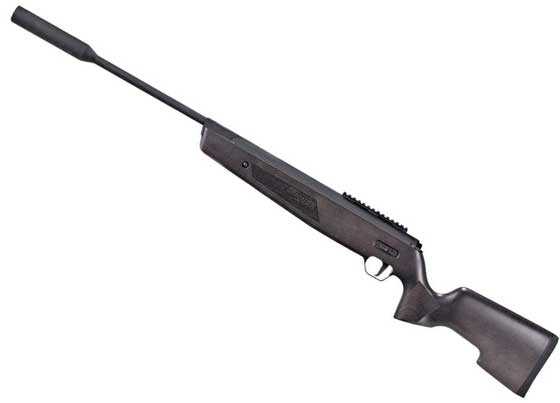
Sig ASP20 breakbarrel rifle.
Part 1
Part 2
Part 3
Part 4
Part 5
Part 6
Part 7
Part 8
Part 9
This report covers:
- Background
- The complex part
- Air Arms 16-grain
- H&N Sniper Magnum
- JTS Dead Center
- JSB Jumbo Monster Redesigned
- Don’t create new universes
- H&N Baracuda 15
- H&N Slugs 0.218-inches diameter
- H&N Baracuda 18
- H&N Baracuda Hunter Extreme
- Discussion
- Summary
Today is a simple report that is overwhelmingly complex. It doesn’t need to be complex if you trust me and just concentrate on the one thing we are trying to learn. There is a second teaching point that I will address at the end, but I want to downplay that one to keep from confusing everyone.
Background
When I originally received the Integrix 2-12X36 scope to test for you it came with a one-piece scope mount attached. Because the Integrix scope tube is 34mm in diameter I had no rings to mount it in, so I had to use the one piece mount that was sent. You guys know how much I dislike one-piece scope mounts and this one fought me — not because it was one piece but because it has a true Picatinny base and most air rifles will not accept true Picatinny bases. But the Sig ASP20 breakbarrel has a true Picatinny base that will accept one, so I removed the Whiskey3 scope and mounts from that rifle in preparation for mounting the Integrix scope.
But Leapers, who provided the Integrix scope and mounts, reacted swiftly to my problem and the very next day I had two-piece 34mm rings that allowed me to mount the scope on many air rifles. I mounted it on the Norica Omnia ZRS that I had originally wanted. That left me with the ASP20 from which the scope had recently been removed. And THAT was an opportunity to test something else. If I remounted the Whiskey3 scope on the ASP20 rifle, how much, if at all, would the zero change?
When I removed the scope I only loosened the screws that held the base of the scope rings to the rifle’s receiver. The scope remained securely in the rings where it has been since 2018.
The complex part
If you understand all that, what is so complex? Well, I had shot 8 five-shot groups on April 19 with this rifle and scope and I wanted to shoot all those same pellets again. So I did. That gives us 8 pairs of five-shot groups to compare. The complexity comes with me showing you both groups for each pellet — the one fired on April 19 and the one I shot May first for this report.
Can you look at 8 comparison groups and not fixate on the size of each group? Because that isn’t what we want to see today. We are interested in seeing how much each group may have moved after the scope was remounted. The groups for each pellet shot today will be both better and worse than they were back in April.
Remember, we are interested in WHERE each new group moved, if it moved at all. Of course I will tell you the sizes of all the groups, but please don’t invent any universes to explain the reasons for the group growth/shrinkage for this rifle/scope combination! Here we go.
Air Arms 16-grain
On April 19 the rifle put five Air Arms 16-grain domes into a 0.17-inch group at 10 meters. On May 1 the rifle put five of the same pellet into 0.317-inches at the same 10 meters. The two groups are almost in the same place.
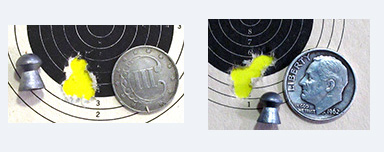
The Air Arms 16-grain didn’t move that much after the scope was remounted (right). The photos aren’t the same scale so don’t be confused. Apr. 19 – 0.17-inches. May 1 – 0.317-inches.
H&N Sniper Magnum
On April 19 the rifle put five H&N Sniper Magnums into a 0.181-inch group at 10 meters. On May 1 the rifle put five of the same pellet into 0.421-inches at the same 10 meters. Again the group didn’t seem to move much.

The H&N Sniper Magnum group didn’t move that much after the scope was remounted (right). The group didn’t move much. The photos aren’t the same scale so don’t be confused. Apr. 19 – 0.181-inches. May 1 – 0.421-inches.
JTS Dead Center
On April 19 the rifle put five JTS Dead Center pellets into a 0.181-inch group at 10 meters. Yes, this group is the same size as the previous one shot with Sniper Magnums on the same day. On May 1 the rifle put five of the same pellet into 0.387-inches at the same 10 meters. This group moved a smidgeon to the right.

The JTS Dead Center group moved ever-so-slightly to the right after the scope was remounted (right). The photos aren’t the same scale so don’t be confused. Apr. 19 – 0.181-inches. May 1 – 0.387-inches.
JSB Jumbo Monster Redesigned
On April 19 the rifle put five JSB Jumbo Monster Redesigned pellets into a 0.247-inch group at 10 meters. On May 1 the rifle put five of the same pellet into 0.191-inches at the same 10 meters. This one also moved just a little to the right.
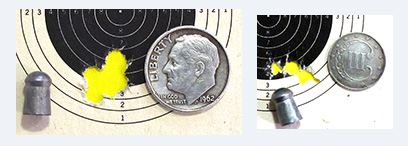
The JSB Jumbo Monster Redesigned group moved a little to the right after the scope was remounted (right). The photos aren’t the same scale so don’t be confused. Apr. 19 – 0.247-inches. May 1 – 0.191-inches.
Don’t create new universes
This last group is why we don’t try to create new universes to explain why groups are larger or smaller on May 1 versus April 19. Some are larger and others aren’t.
H&N Baracuda 15
On April 19 the rifle put five H&H Baracuda 15 pellets into a 0.123-inch group at 10 meters. On May 1 the rifle put five of the same pellet into 0.159-inches at the same 10 meters. These two groups are in close to the same place except the May 1 group might be slightly higher.

The H&N Baracuda 15 group remained in the exact same place after the scope was remounted (right). The photos aren’t the same scale so don’t be confused. Apr. 19 – 0.123-inches. May 1 – 0.159-inches.
H&N Slugs 0.218-inches diameter
The H&N 0.218-inch diameter Slug group moved slightly to the right after the scope was remounted (right). The photos aren’t the same scale so don’t be confused. Apr. 19 – 0.228-inches. May 1 – 0.304-inches.
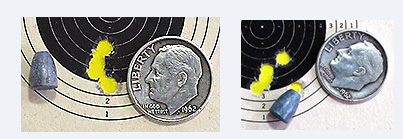
The H&N 0.218-inch diameter Slug group slightly to the right after the scope was remounted (right). The photos aren’t the same scale so don’t be confused. Apr. 19 – 0.228-inches. May 1 – 0.304-inches.
H&N Baracuda 18
The next pellet tested was the H&N Baracuda 18. I shot two groups of them in April because there was a flier in the first group. I didn’t call it a flier, but it was there and it didn’t look to me like the pellet should have done that. The second group had no flier. Apr. 19 0.187-inches. May 1 0.254-inches. The May 1 group is a little lower than the one from April.
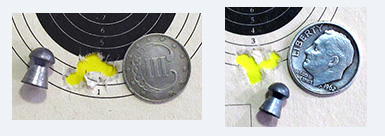
The H&N Baracuda 18 group dropped a little lower after the scope was remounted (right). The group shown on the left is the second group I shot on April 19, after the first one had a flier. The photos aren’t the same scale so don’t be confused. Apr. 19 – 0.187-inches. May 1 – 0.254-inches.
H&N Baracuda Hunter Extreme
The last pellet I tested on both days was the H&N Baracuda Hunter Extreme. This pellet does very well in the ASP20. In April five went into 0.19-inches at 10 meters. On May first five made a 0.158-inch group — the smallest of the test that day. The May group moved slightly to the right and up.
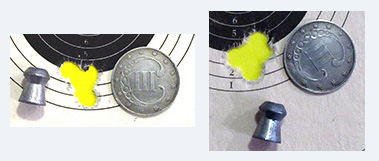
The H&N Baracuda Hunter Extreme group moved a little up and to the right after the scope was remounted (right). The photos aren’t the same scale so don’t be confused. Apr. 19 – 0.19-inches. May 1 – 0.158-inches.
Discussion
The main point of today’s test and report is that the pellets fired while sighting through the remounted Whiskey3 scope remained pretty much where they had been before. Some of the May 1 groups were smaller than those on April 19, but most of them were larger. So BB was a bit off his game for the May first test.
A second point to be made — and this is the lesser point that I mentioned at the beginning — is that you cannot determine accuracy reliably from one 5-shot group. You can’t do it from a single 10-shot group, either, but you will come a lot closer.
I’m sorry that all the pictures were out of scale with each other, but this was one of the most involved reports I have ever written. If I had also scaled the pictures it would have taken several days to complete.
The final point is that this test does not guarantee that ALL scopes and ALL rings will perform similarly when mounted on ALL rifles. What we have today is the result of a premium air rifle mounting a premium scope in premium rings.
Summary
It was fun to venture off the path and do this report. It took me a while, but I think it was time well spent.

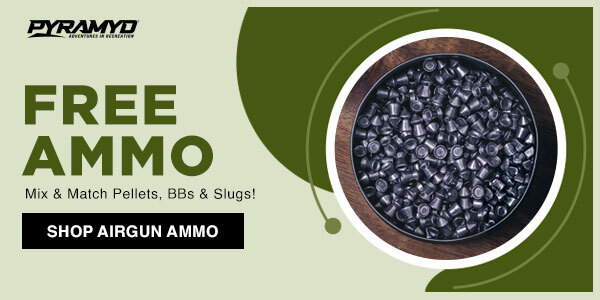
BB: Is it possible, or even likely that temperature and or humidity could be factors in these slight, yet rather consistent changes in POI? Orv.
Orv,
Since I shot indoors I think it less likely. It would require another test on a vastly different day and I don’t know if I’m up to it.
BB
Hoppalong Doc,
I posted this Link in a reply yesterday that is an interactive calculator that you can find your exact answers to your questions easily:
https://www.jbmballistics.com/cgi-bin/jbmtraj-5.1.cgi
Enjoy finding your answers!
shootski
B.B.
I think the report is more a testament of you and the asp20 than anything else. I am amazed at your consistency most of the time. Yes 10 shot groups would be better so would 20 shot groups. How much time do you have doing 5 reports a week. Thanks for your work. I enjoy these tests more than the airgun company buisness reports but I think the business reports are more important.
PS you were going to do a 100 yard accuracy report on the RAW do you still have it? Might be a candidate for the new integrix scope.
Don,
The Raw and Integrix. Yes to the hundred-yard test of the RAW and yes to an Integrix on it, but not the one I have. A higher power one is coming that should be ideal.
BB
“…the pellets fired while sighting through the remounted Whiskey3 scope remained pretty much where they had been before.”
B.B.,
Well said, and remarkably so; thank you for your painstaking work in preparing this report…
…your excellent results are a great payoff for all your efforts…
…especially for those of us who didn’t have to do the work, yet reap the benefits of it. 😉
Blessings to you,
dave
Tom,
Just as a thought, is it possible the slight shift could be avoided by using a torque wrench when reinstalling a scope on the same rifle?
Siraniko
Siraniko
My thoughts on that. If the scope mounts are fully engaged with the rail (bottomed out) when the screws stop turning, applying more torque simply stretches the screw threads away from the head increasing the tension on the fastener. It helps in preventing it from coming loose.
Too much torque will cause metal fatigue and possible failure, as in the head shearing off.
Now if the scope rings have not fully seated into the rail when the screw bottoms out and continued tightening actually forces the two to engage tighter by bending things a bit more torque may have some influance if the rail engagement is not exactly equal on both sides.
Metal has some elasticity and that provides the tension when tightened. It wants to spring back but once that elasticity is exceeded metal is destroyed at a molecular level and the tension will be gone and the screw will become useless if not already sheared off.
The reason we do not reuse high torque bolts like engine head mount bolts. They have been torqued / stretched to the limits and lose most of their elasticity needed for a second use.
Coincidentally I have just remounted a cheap scope onto my stocked pp700. I used another set of rings, but surprisingly it was only a few clicks out at 20 yards from the last time it was on the gun around a year ago.
Bob M
If we exclude excessive force being used on the screws, can we conclude that an extra half turn might, indeed, place a different load on the sides of the rings where they engage the rifle? Or a half turn less?
I think Shiraniko was thinking in these terms as opposed to over tightening. It is certainly possible that the torque of these screws might have cause the slight variation of group position that we saw.
These differences in relative group positions were certainly within my own standards of accuracy. At the least,, I think one might take away from this test that they will very likely still be “on the paper” after such a swapping back and forth of scopes.
Ed
Ed,
Yes, tightening screws more or less will change things, but how?
My point was that once a solid block of aluminum is firmly seated to another chunk of metal more tightening of the screw will not change the shape or position of the mount itself, but the screw, yes. It will stretch and be under more tension.
Every screw or bolt has a recommended torque simply determined by its size, type, material or use. Stated or not. After tightening thousands of screws on aircraft access panels we jokingly refer to the proper torque as ‘elbow clicks’. You get a feel as to how tight they should be.
There may also be a difference between the head type and transferred stress distortion depending on the scope mount design. Is it a see-through design? Does it have countersunk or button head mount screw? Are the edges and angles of the mount entirely compatible with the mounting rail? If not, changes in tightening torque may distort things depending on where the stress points develop.
If it’s being remounted on the same rifle, I don’t think you would have too much of a change but will temperature change anything? How many miniscule things will it take to make any difference?
Bottom line, if tightening changes the shape of the scope mount to better engage the rail, distortion will depend on how tight it is. Unless it is completely distorted the same, every time it is tightened. A constant repetitive torque will minimize changes in it, on the same rail. Transferring to another airgun and rail may change everything.
I’m sure you are right, Bob. I guess what I was getting at was that the very small changes in the relative positions of the two otherwise identical tests (both indoors), could have been torque as easily as humidity or temperature.
Something caused those differences, regardless of how small. My guess is that the reasons were also quite small.
Ed
Siraniko,
What they said.
My answer? I don’t think so.
BB
There must be a good reason why they tell you to tighten mount screws slow and evenly.
Bob M,
Scope tubes are usually thin aluminum and can be crushed or deformed easily. Been there, done that, have the t shirt.
I do some part-time fill in at our LBS, Local Bike Shop. When assembling any bike we grease the threads and run them home. The lubrication provides a more even tightening than running the fasteners home dry. We hand tighten everything and do NOT use power tools for fasteners. Part of the reason for that is that the usual medium is aluminum or very thin other materials. Carbon fiber, in particular, doesn’t like over-torque.
I always lube my wheel studs with a LIGHT oil. That allows the wheel nuts to seat evenly AND keeps the wheel studs from rusting.
And that’s the right way. I oil everything going into aluminum and most everything else. It reduces heat and friction that promotes galling. Heavy duty stuff requires anti-seize… like wheel lug nuts!
Most everything inside aircraft requires bolts with self-locking nuts. No nuts – Heads are drilled and safety wired to prevent loosening and backing out, but the outside is nothing but screws and rivets.
BB,
Caution! I am not advocating for you to do further testing!
I do not know how others see this, but unless the rifle and scope have incredibly precise mounts, there is no way you can remove and remount a scope and expect it to be spot on as Hollywood so often shows us.
As this test illustrates, if this was repeated at 25 yards, the shift off previous impact points would be further exaggerated. If this was 50 yards, it would likely be even more.
Are there precision mounts that would allow such? Maybe. I would hate to see the cost of such. Also, I am certain you would have to use a torque wrench when mounting and remounting the scope.
Can it be done. Most likely, but by sheer luck of the draw. Hollywood does it again.
“Hollywood: Advice Given Is For Unqualified Unprofessional Professionals and Amusement Purposes Only – Do Not Try Anything Suggested At Home.”
FM,
LOL! So true.
Tom,
For me, at least, the change in the scale between the before-and-afters makes it easier to ignore the different group sizes. If you try this experiment again (hint, hint), say with another known-accurate air rifle such as the TX200 (hint, hint), you might consider doing that again.
Michael
Michael,
Oh, you enabler, you! 🙂
BB
Tom,
I’ve learned enabling from the very best, Master Gaylord!
As I continue to think about it, would it be better or not as good to use a different scope with the TX200 than you used with the ASP20? It could be whatever scope is currently on it (assuming it is presently scoped). If the TX200 is currently scope-less, well, it would be shooter’s choice! Are there any other scopes you intend to test lounging around your laboratory?
How about a cheap scope on a TX200? Or an exquisite scope? Or first one, then the other? Does the quality of a scope have an effect on its ability to maintain its POI (or POA? Zero?) after being removed and then reinstalled on a known-accurate air rifle? (Please forgive my ignorance, I’ve been away from airgunning for a while lately.)
I am not suggesting combining three or four different experiments. That would be a mess.
However, first repeating the ASP20 test with the TX would be one interesting test. Then repeat it but with the TX using a cheapy scope. If the pellet choices are the same, the test might reveal the difference in precision of the two scopes resulting in an increased sensitivity to scope-swapping and swapping back, which from my reading many shooters do when they cannot afford to scope each rifle in their collection.
It also might demonstrate just how much better is the same shooter shooting the same pellets out of the same known-accurate air rifle with a significantly better scope.
What is better, a fine scope on an OK air rifle or a fine air rifle with an OK scope?
I have watched many a guitar video where comparisons are made between an excellent guitar played through a so-so amplifier vs. a so-so guitar played through an excellent amplifier. (Care to guess which is almost always the result and which most pros would choose for a live gig?)
Michael
Michael,
What you hinted at is not a mess. It’s a series! I like it!
I have listened to playoffs of ukuleles, similar to what you mention. Top-end ukes versus affordable ones. On You Tube I can’t hear any difference! But live? Maybe. You gotta hope, for what those expensive ones sell for!
I see quite a few reports from what you have suggested and the TX200 Mark III is the perfect airgun to use, because it is so neutral-shooting. I can even use the Tony Leach tune versus the standard factory tune for each scope tested.
And Michael, I can’t hazard a guess which guitar combination would win in the illustration you give.
BB
Tom,
I’m glad I have been a positive and constructive enabler. :^)
Regarding Ukes and frankly any musical instrument is this absolute truth: an exceptional player will make a poor instrument sing, but a so-so player will sound just barely better than so-so on a world class instrument. Derek Trucks on a $70 guitar through a $70 amp will sound 10,000 times better than I would sound playing a $7000 guitar through an $80,000 amp. And I am not just describing stuff like speed and accuracy. The tone is mostly a product of superior technique. Now Derek Trucks playing a Gibson Custom Shop SG through a Howard Dumble amp would be sublime. (And he would play even better, because the gear would inspire him to do so.)
In person, and by that I mean not at a concert but in a small, quiet room with no amplification involved, just a player –the same player — going from one uke to another in front of you, you would hear differences quite clearly. And keep in mind that you cannot accurately hear what your uke sounds like as you play it. The sound goes away from you, into the room. What you hear is not what those in front of you hear. To hear you play your uke, you would need to hear a recording, but that would still not begin to do the sound justice and would likely discourage you needlessly. I promise you sound better than that would sound, Best to have someone else to play your uke in front of you.
Because of the above dynamic, one should never go shopping for an acoustic string instrument alone. Always bring with you someone who can play the instrument in front of you so you can judge its tone. (Or have a salesman do it.) Electric is of course a different matter.
I think it is wonderful that you are taking up the ukelele. It is a fine instrument with an esteemed history and rich cultural heritage. It is also regarded by many to be the single best traveling instrument for its portability and suitability for casual vocal accompaniment at campfires, cookouts, and other small get-togethers. Go to a small gathering, pull out your uke, and a few folks will quietly chuckle at the tiny guitar-thingy. Then strum a few chords in a simple rhythm, and everyone will nod their heads, lightly tap their feet, and smile. Never does it fail to be a mood-improver for everyone around.
Just don’t hand it to a kid! (Seriously.)
Michael
Tom,
D’Oh! I forgot to answer the which is more important for a live gig, the quality of the guitar or the quality of the amplifier question. An experienced pro is faced with a regrettable choice at a live gig. He or she can play an excellent guitar through a mediocre amplifier or instead play a mediocre guitar through an excellent amplifer. Aaaah! Better guitar or better amp? Better amp, 90-something percent of the time.
Michael
BB
Are the differences comparing April results to those in May considered normal distribution? I suspect the answer is yes. But if you were a robot and could shoot without tiring it may indicate that this rifle is more consistent after 30-40 shots than before.
Deck
Deck,
Good point. I would never have thought of that.
Michael
B.B. and Readership,
Tom tried to get you to understand the gist of this test is more to show that a scope can be remounted on a true 1913 PICATINNY Base and how much it will deviate from the pre-dismount POI. Dismounting and remounting a scope on virtually any other Base system (like the dovetails on a TX 200 is a effort in futility in my opinion) B.B. can do it if he has time to show the results. The POI usually won’t be wildly off but in most cases it won’t be as good as on a true 1913 rail.
A better test in my opinion would be to do the test with a known accurate and repeatable (box test) scope. The rings would remain attached and the scope moved to another rifle with a 1913 rail. Since the specifications guaranty that no scope ring movement on the scope tube is required and the cross slots are perpendicular to the scope fore-aft axis it is by design going to give better results in multiple mount dismounts from various 1913 rail rifles. If you look at a 1913 rail they have the cross slots numbered to allow you to record the rifle/slot/scope data for every combination YOU own and use; much less frustrating and quicker scoping up.
The bottom line is the standardization mightcould allow you to own fewer scopes and certainly fewer bases. Now what manufacturer is going to want to do that for Airgunners?
shootski
shootski,
I was assuming picatinny, not dovetails, but you know about assumptions. If the TX has a picatinny adapter, and the adapter is not moved during the test, would that make the test worthwhile?
Michael
shootski,
If a test could show that outfitting all of one’s air rifles with quality picatinny adapters (cheaper than scopes, anyway) could allow one to purchase fewer scopes (and perhaps a better scope or two instead) I am all for it. But then again, I have no financial interest in the air gun industry.
Michael
Michael,
Although my post followed yours in sequence it was to the Readership in general and B.B. specifically.
I would find it difficult and certainly very time consuming to write a formal Test Plan based on your stated requirements.
We would need to schedule many meetings to validate your requirements.
shootski
Michael,
Unfortunately most if not all of the picatinny adapters are not made MIL-STD 1913 PICATINNY so your suggestion is no better for airgunners than what exists currently. The SIG ASP20 1913 PICATINNY rail works because SIG went to the expense of meeting or exceeding the MIL-STD and using a cold Laser welder to avoid spring tube distortion. I would also suspect that since they built the ASP20 with a Patented breech block that they also used some alignment Jig to control the barrel bore axis to 1913 PICATINNY rail Centerline.
Cheep and Cheeper airguns are cheep for a variety of reasons!
Unfortunate that quality is so poorly understood by the many!
shootski
“Unfortunate that quality is so poorly understood by the many!”
shootski, years ago I used to think that about students in my writing classes, but then I stopped being so judgmental (although it was still my job to grade them as I tried to teach them). Not everyone is cracked up to be good at writing, and they are probably trying their best. I, for one, am not naturally civil in my discussions with others, but I keep trying to be so. ;^)
Michael
Tom,
Above you asked a question about something not-air guns oriented. But it sure could be.
“Top-end [PCPs] versus affordable ones. On You Tube I can’t [see much] difference! But [in my hands?] Maybe. You gotta hope, for what those expensive ones sell for!”
We’ve discussed this price to performance issue here many times, but it is fun to bring up once in a while, no? Is a $1500 PCP 3 times better than a $500 one? Well, maybe 1.7 times better. And a $3000 PCP? Well, it’s maybe 2 times better than the $500 one. And the . . . Yes we get the point. The Law of Diminished Returns is a balm for those of us on a budget.
Michael
Michael,
Honestly, with the Avenger in the world I think 1.2 times better for the $3000 pcp. It’s the trigger and perhaps some ergonomic adjustability.
BB
B.B.,
You need to add the barrel manufacturing process and quality control and I will mostly agree.
The added cost might also have an effect on material(s) choice, tolerance parameters/stability over time, and machining/workmanship level.
Yes an AK-47 or an Uzzi operates but will it also please on an aesthetics level like say, an Anschütz or a SIG SSG 3000 while operating as well or better?
shootski
shootski
I would say that on two different days shooting 5 shot groups, without removing the scope, those groups would be typical.
Why are sighting shots used?
Don
Benji-Don,
“Why are sighting shots used?”
I suspect your question is rhetorical Don!
I will submit sighters are needed before every shooting sesion (if practical) because you the shooter have physically and neurologically changed. Especially your eyeball (physically) and eyeball to brain connection (neurologically) and even your cheek weld due to swelling and shrinking of your face.
Yes, to some degree your rifle/sight system/ammunition (projectile and powerplant status) will change because of atmospheric/environmental changes but in this case mostly you the shooter have changed.
shootski
My right eyeball changes by the minute. But for the past month I have had a bubble behind the pupil, and its outline drives me to distraction. That has been a constant
Michael,
I am a person who’s very continued existence depended on vision. It pains me to know your condition’s current treatment is painful and in the end seemingly hopeless to boot.
I hope and pray the cutting edge work of the researchers at Harvard Medical comes together faster rather than on the FDA’s bureaucratic timeline so your eyeball(s) can be rejuvenated at the earliest opportunity.
sincerely,
shootski
shootski,
Thank you very much for that.
The vision in my right eye, where I have had macular edema, will not return. Unfortunately, during the two years since I first developed this, despite the injections, the amount of tissue death in that macula means there is no vision remedy. So far the injections do prevent losing the organ.
Other than a cataract my left eye is OK. My opthamologist has warned me, however, that I might develop macular edema in thatee as well. He said he has had many patients who suffered that exact fate. So I am anxious about that.
It is good I have never been a smoker, and I must keep my blood pressure from being high. Other than that I must be diligent, so if I begin to have macular edema in my left eye, I can have an emergency opthamologist visit, diagnosis, and injection right away. Prompt attention is important. As the disorder (in my case, at least) it happened literally overnight, so every morning I self-administer a test my left eye with an Amsler Grid.
You cover an eye and with the other look at the grid’s center at a comfortable distance. If your peripheral vision is OK, then it’s good. If the lines are wiggly at any portion of the grid, or if there are dark spots or blank portions, get to an opthamologist ASAP.
Michael
Here are bad Amsler Grid views.
Tom,
shootski replied to me above, but he indicated he prefers comments directed to the Readership in general and you specifically. That is why I’m responding down here.
shootski says, “The formal test plan alone would require many meetings,” and it would prove “difficult and certainly very time consuming to write a formal Test Plan.” He also wrote that, for engineering reasons I don’t understand, a picatinny adaptor on the TX200 wouldn’t work for the test. (His comment is above.)
I thought it might be a mess. Just forget it, I guess. :^(
Michael
Michael,
I didn’t know where it would be appropriate to respond to your: “shootski replied to me above, but he indicated he prefers comments directed to the Readership in general and you specifically. That is why I’m responding down here.”
I’m afraid you missed my point and seem to have taken it personally. I don’t have a clue how to fix that other than to point it out here.
Additionally one of your replys came through as an email notification grouped with two other of your replys to me and seems to have disappeared?!?!? :
“Hey shootski,
Michael replied to your comment on Sig ASP20 rifle with Whiskey3 ASP 4-12X44 scope: Part 10. Comment content:
shootski, Um, so you disagree about the Avenger? Michael
Reply to this comment: /blog/2023/05/sig-asp20-rifle-with-whiskey3-asp-4-12×44-scope-part-10/#comment-502467”
I do NOT know what you think i disagree on or about the B.B.’s tested Avenger? I pointed out that the barrel manufacturing process and quality control would be another facet i would want to know about.
My reasoning is that one Avenger barrel among many is likely to be extraordinary just as in any other manufacturer’s gun; only because of serendipity.
You may want to read these reviews they are instructive: /product/saber-tactical-avenger-picatinny-rail?a=10165 Even with this “upgrade” there is still no verbiage that says MIL-STD 1913 PICATINNY rail.
No Blue Smoke.
Straight talk only,
shootski
shootski,
I always reread comments I comment on, and when I did so regarding your Avenger comment, I saw “I will mostly agree.” I then deleted my following comment, because I had missed where you made your conditional agreement on the Avernger clear. I was correcting my mistake by deleting my comment.
I honestly confess I must not understand your distinction between some of your comments on subject matter being discussed and others. My approach has always been that any comment in the blog is for all to read and perhaps comment on, be the initial comment directed to an individual or not. For example, if I respond to one of RidgeRunner’s comments, I expect that third parties might express their thoughts in addituion to any provided by RidgeRunner.
Michael